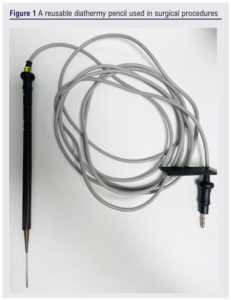EDITORIALS
Delivering greener surgery; small changes matter
Tripathi A,1,2 Al-Saadi N,1 Wall M,1 Garnham A1,3,4
Introduction
Countries worldwide have committed to reducing carbon emissions to mitigate the detrimental effect of climate change on the environment. The UK has committed to net zero carbon emissions by 2050. Significant changes are required across all industries, including healthcare, to achieve this target within the deadline.1 Currently, healthcare systems are estimated to account for 4–5% of the overall global carbon footprint, with surgery identified as a major contributor.2,3
The importance of vascular surgery services working towards reducing their carbon footprint has recently been highlighted in an article by the Vascular and Endovascular Research Network et al.4 In this editorial we discuss how simple small changes such as replacing a ubiquitous single-use surgical instrument with a reusable alternative could make a significant difference to carbon emissions and help achieve improved environmental sustainability.
Surgery and its environmental impact
A single surgical procedure in the UK is estimated to produce approximately 104 kg CO2, which is equivalent to driving a petrol car for 300 miles.3 With over 3 million operations being performed in the NHS each year, this figure highlights the importance of making changes to surgical practice to minimise the environmental impact.5
Studies have previously highlighted that the use of medical equipment contributes significantly to carbon emissions, with single-use items accounting for up to 78% of the carbon footprint in some cases.6-9 Studies have found that 59% of the total NHS carbon footprint is associated with the entire healthcare supply chain, and 71% of the carbon footprint in healthcare globally.6 Although continued use of single-use items and recycling is commendable, the impact on reducing the carbon footprint is limited.10 Using reusable medical equipment as a substitute for single-use surgical instruments has the potential to reduce the carbon footprint of surgical cases by 50–97%.10-13
Studies comparing the carbon emissions from surgical procedures between different countries found that developing nations such as India were able to achieve a 30-fold reduction in carbon emissions by using reusable equipment due to saving on the manufacturing and transportation of each item.14 Despite reusable equipment being a more environmentally sustainable choice, the risk of cross-contamination is often cited as an impediment to change.15,16 However, there is evidence to the contrary, showing a minimal risk of cross-infection.17 Therefore, simple steps such as replacing commonly used disposable surgical equipment in the operating theatre should perhaps be the starting point in the pathway to greener surgery.
Diathermy pencils
Electrosurgical pencils, commonly known as diathermy pencils, are one of the most frequently used single-use surgical instruments in cases in the UK. However, these can be replaced with a durable and long-standing reusable alternative (Figure 1).

Whilst evidence exists regarding the carbon emissions produced during the operation of such devices, no current publication addresses the carbon footprint related to each instrument’s manufacturing process. By calculating the carbon footprint associated with each component of the diathermy pencil, we have deduced that the production of each unit emits over 3.3 kg CO2.18-24 A breakdown of this is shown in Table 1.

This constitutes approximately 3% of the total carbon emissions from a single operation in the NHS. Assuming a new diathermy pencil is used in half the operations and approximately 3 million surgical procedures take place within the NHS annually,5 the cumulative carbon emissions from the manufacturing of diathermy pencils each year amounts to roughly 5 million kg of CO2, which is equivalent to the weight of a new roof in the O2 arena each year. When accounting for additional factors involved in the supply chain of each diathermy unit including packaging, transportation and distribution, this figure would increase further. This underscores the environmental importance of substituting commonly used single-use instruments with reusable counterparts. This can play a pivotal role in advancing greener surgical practices, fostering greater environmental sustainability, and reducing the carbon footprint in surgery and healthcare.
Conclusion
Given the growing impact and escalating concerns surrounding climate change, swift and well-informed decisions regarding standard operating procedures are imperative to minimising the impact of climate change and securing a more promising future for our planet.
We know that healthcare, and particularly surgery, is a significant contributor to carbon emissions globally. It contributes to a modest yet noteworthy portion of the UK’s annual carbon footprint. We also know that there is substantial evidence to support the transition from single-use instruments to reusable alternatives. Diathermy pencils serve as a compelling illustration of a commonplace single-use tool within operating theatres which could be effectively substituted with reusable counterparts with a reduced carbon output. Such shifts may lead to a considerable reduction in carbon emissions associated with surgical practices.
Although we have concentrated on diathermy pencils, it is important to consider this as a representative case and to foster an environment where we evaluate all disposable surgical instruments used in operating theatres. For example, similar tools, such as harmonic scalpels used in laparoscopic surgery, may also be substituted with reusable alternatives. Even if a handful of healthcare trusts embark on this transition to reusable equipment, the resultant decrease in carbon emissions could be noticeable. This collective effort would propel us closer to the aspiration of achieving net zero carbon emissions. This could foster a tangible positive influence on our environment and the planet at large, whilst allowing us to reflect on our current practices and the impact we have on the environment.

Article DOI:
Journal Reference:
J.Vasc.Soc.G.B.Irel. 2023; 3(1): 2-4
Publication date:
November 19, 2023
Author Affiliations:
1. Russells Hall Hospital, Black Country Vascular Network, West Midlands, UK
2. University of Birmingham, Birmingham, UK
3. Royal College of Surgeons of Edinburgh Surgical Speciality Board, Edinburgh, UK
4. Vascular Society of Great Britain and Ireland, UK
Corresponding author:
Nina Al-Saadi
Vascular Surgery Department, Russells Hall Hospital, Black Country Vascular Network, West Midlands, DY1 2HQ, UK
Email: [email protected]











